|
FAQs about Mussid Coral Health/Disease 4
FAQs on Mussid
Disease:
Mussid Disease 1, Mussid Health 2, Mussid Disease 3, Mussid Disease 5,
FAQs on Mussid Disease by Category:
Diagnosing,
Environmental (Pollution/Poisoning, Lighting...),
Nutritional,
Social (Allelopathy),
Trauma,
Pathogenic (Infectious, Parasitic, Viral)
Predatory/Pest,
Treatments
Related Articles: Coral Pests and Disease; pests, predators,
diseases and conditions by Sara Mavinkurve, Mussid Corals,
Related FAQs: Mussids 1, Mussids
2, Mussid Identification,
Mussid Behavior, Mussid Compatibility, Mussid Selection, Mussid Systems, Mussid Feeding, Mussid Reproduction, Stony/True Coral, Coral System Set-Up, Coral System Lighting, Stony Coral Identification, Stony Coral Selection, Coral Placement, Foods/Feeding/Nutrition, Disease/Health, Propagation, Growing Reef Corals, Stony Coral Behavior,
|
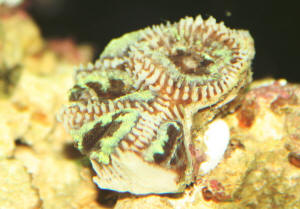
|
Re: re: Frag Blastomussa Wellsi... allelo
7/15/13
Update. After a few days the frag split and it looked like a pie with a
wedge removed. It took a few weeks for it to heal. I did try a second
frag but that one did not cut clean and you can't even tell what it is.
<Give it time>
But it is alive so will just wait and see.
<Good>
A couple other things happened in my tank. My candy cane had one head
that was bent a bit down and then started to look as if the flesh was
pouring down. It was tear drop shaped and stayed like that for a couple
weeks. I snipped it off and it looks like I now have a candy cane frag.
I have a Platygyra for about 2 years. Never saw it eat so I don't feed
it. And I never saw any tentacles. It started to recede and about half
of it died away. I moved it to a new spot and it has come back nicely
and has recovered around half the loss.
<Ahh!>
One evening about a half hour after lights went out I looked in my tank
with a light and the Platy had long tentacles flying around. Never saw
this before but it explains why my open brain has been deflated at
times. Just sharing, am
<Thanks for this follow-up. Bob Fenner>
Couple questions; Pterapogon fdg., Scler. stings
1/2/13
Hi Crew and a happy New Year, I haven't asked anything in a while so
here are two issues. I bought 2 pair of Banggai Cardinals over the past
six months and all starved. The would spit out the food. I guess they
wanted only what they were used to. I tried pellets, flakes,
decapsulated brine shrimp eggs (which most fish go crazy for), my own
home made minced fish.
They were all in good shape but they lasted 2 weeks and that was it. And
they were from different stores. You would think they would take
anything if really hungry.
<... I'd have tried live and frozen/defrosted foods of appropriate size>
Anyway, I decided to try once more and after a week of watching them
spit out everything I went back to the LFS and asked them what they
think will work. And they suggested Hikari frozen brine shrimp. Well, it
really worked. They are now much livelier and run for all the foods but
they still spit out all except the bs. It does contain supplements so do
you think they can survive on it.
<I'd expand on the menu... Read here:
http://www.wetwebmedia.com/banggaifdg.htm
and for Apogonids in general>
I had a really nice Lobophyllia. It was oval about 3 inches long and 2
wide. Red outside and bright blue center. Had it about 3 years. Any time
an Acan or Candycane fell on it they melted away
<?! why are other Scleractinians falling?>
and you could hardly see any mark on the lobo. Recently an Acan fell on
it with the same results. About a week later I rearranged my rock so
that my Trachyphyllia would have room to spread so I removed all my
coral, rearranged everything and put the coral back. The next
day I felt a bad sting on a finger and it took a week till it felt
normal. And then the Lobo just disintegrated in about 2 days.
What could have triggered this event. Thanks, Sam
<The contact with both. Bob Fenner>
Lordhoweensis heads shifting on stalk
12/24/12
Hi wonderful experts. I just observed a scary thing with my
gorgeous little Lordhoweensis coral, and I'd love some advice. I
got it about 6 months ago, three heads arrayed around a single stalk.
Since then it has become the picture of excellent health. The
heads are all about 50 percent bigger than when I got it. They
fully expand and eat meaty seafood voraciously. Two new large
heads grew, and six new little heads are forming around the perimeter
and growing fast.
<Good>
This morning when I got up, I was shocked to see bare skeleton at the
back of the stalk, and my initial impression was that one of the heads
had vanished. But I counted, and they are all there. They
have shifted, en masse, about a half inch toward the front of the tank,
as if they are sliding across the top of the stalk!
<Mmm, something moved this colony... it's not ambulatory by itself>
I cut back the water circulation near it, although I do not think it was
too fast. Now I am fearful that the whole set of heads is going to
just slip off and go drifting away in the tank.
Is what I've seen common? Do you think the heads will fall off?
If they do, what sort of first aid is required?
<Not common, heads/corallites shouldn't fall off, checking water quality
and adding a bit more iodide-ate is all I'd do, along w/ investigating
what animal (added or not) might have moved this animal... Do you have
large molluscs, urchin/s present?>
I would hate to lose this lovely, otherwise very healthy coral.
Tim
<Mmm, do review the Health FAQs for Mussids, Scleractinians on WWM...
Bob Fenner>
Re: Lordhoweensis heads shifting on stalk 12/24/12
Bob - Thanks for the quick reply! I recently added a fighting
conch, and a single Mexican Turbo snail to help control a huge growth of
purple ochtodes. Might they move a coral colony?
<The conch, definitely. Place all unattached/movable invertebrates out
of its potential way>
I never add iodine,
<Mmm, I definitely would. See Marco's article on WWM, the FAQs re>
but I do a 25 percent water change weekly, so water quality should not
be an issue. I only test calcium and alkalinity every month or
two, but I'll do it now to make sure. All parameters have been
rock steady for at least a year (Ca 450 and Alk 10-11 dKH), and pH holds
steady at 8.1-8.3 (it's 8.2 right now) and I keep salinity (SpG) at
1.025. The weird thing is that this coral is the picture of
health... fully expanded, feeding tentacles usually extended, and eating
well. It's not as if the coral is weak or dying.
<Just likely pushed about>
I looked very closely and gently prodded it, and I confirmed my
suspicion of what's going on. All five heads simultaneously
detached from their skeleton but somehow remained connected to one
another. This group drifted down-current less than an inch and got
hung up on the edge of the skeleton, where they settled down into what
appears to be a new position of stability. Maybe they will
re-attach. Fascinating, if a bit scary.
Thanks again! I'll let you know what happens.
Tim
<Real good. BobF>
Re: Lordhoweensis heads shifting on stalk 12/24/12
Bob - The fighting conch. Wow, there's no end to what I have to
learn.
<Ah yes; bruisers and cruisers>
I can easily move the conch to a different tank, which I'll do today.
Thanks for the info! Is there any chance that the heads will
re-attach to the skeleton in their new location?
<Oh yes>
Merry Christmas! And thanks again!
Tim
<Cheers! B>
Can a Lordhoweensis head do well sitting on aragonite substrate?
12/27/12
Hi wonderful experts! Bob Fenner saved the life of my
Lordhoweensis by letting me know that the cause of its dislocation was
my fighting conch. I relocated the conch. But one of the
heads has come loose and floated away.
I tried using gel superglue (CorAfix) to glue the head back to its
skeleton, but the enormous amount of mucus kept it from sticking.
At this moment the head is sitting on the bottom in a place well
sheltered from current but also well lit. Shockingly, after all
it's been through, it still looks very healthy and it just ate a big
piece of Mysis!
Here is my question: I have no problem just leaving it where it
is. It is sheltered enough that it should not drift away,
and it's getting good light. But will it do well just sitting on
sandy aragonite?
<Likely so>
Or must I attempt to stick it to a rock? If so, how? Thanks!
Tim
<I'd leave it be for now... perhaps when there's more of a skeleton in a
few months it can be picked up, placed on rock. Bob Fenner>
Re: Can a Lordhoweensis head do well sitting on aragonite substrate?
12/27/12
Bob - Thanks! Will do.
Tim
<Thank you. B>
Help... Mussid hlth. 7/2/12
I recently bought a green Lobophyllia off the internet
and when i received it almost all of the water had leaked out of the
bag.
<Happens; not generally resultant in death>
There was still a small amount in there but only a portion of the coral
was submersed. I did all the proper acclimating for at least a hour
and
placed it at the bottom of my tank in the sand.
<... better on rock>
Its been about six days an it still hasn't opened up,
<... needs strong lighting, moderate water movement; and a dearth of
allelopathogenic neighbors/tankmates>
what i mean by open is it hasn't puffed up the spikes are still showing,
and my water parameters are normal.
<... what?>
The parameters read ,calcium 430, magnesium 1450 and alkalinity 8.3 I
could really use some help, thanks.
<... Read here:
http://www.wetwebmedia.com/MussidDisF4.htm
and the linked files above. Bob Fenner>
Hurting bubble and doughnut coral 6/29/12
Hello Crew,
<Felix>
I have 2 bubble and an Indonesian Scolymia sp
(doughnut coral) that are not doing so great, they're
still extending their tentacles, albeit poorly.
But there's part of their skeleton that has turned black. The coral
refuse to extend near the black area of the skeleton. Should I remove
the dying part, and how the best way to do it?
<I would not remove the necrotic tissue; but would make up a slightly
lower (a few thousandths) spg solution of seawater (or just add fresh to
a portion of the system water) and a ten times dose of iodide-ate for a
five minute bath>
I suspect the infection started because the bubbles fall from the rock
near a lobo coral.
<? What? If too near, I'd move one or the other>
the Scolymia did not
acclimatize well and has never accepted feeding. Water parameter is
within the norm, PH 7,9 salinity 1.025, nitrate 0, phosphate 0,
<Chemophotosynthates need some (measurable) NO3 and
HPO4. I'd remove whatever chemical filtrants you're using here>
calcium 400, alkalinity 9, magnesium 1200.
My second question is why these corals are not doing well (I also have
several other LPS not doing so great although they're still extending).
<See above. They're likely starved>
My system is 90g, with an oversized DIY skimmer (rated for 150g) running
non stop, NP-Biopellet reactor, and Rowaphos fluidizer.
<Ditch these last two. Unnecessary and expensive>
Additives are Grotech Ca, Mg, and Alk supplied daily via dosing pump
(balling light). Lighting is DIY 3wx32 LED fixtures, mix of Royal blue
and cool white (50/50). Do you think the light is overkill as some of my
LPS won't extend their polyp in direct light?
<Doubtful; no>
SPS seems to be doing fine of course. Or is it lack of nutrition
from over filtration?
<Ding ding ding! Yes>
Do you think I could benefit from using a timer for my skimmer?
<Maybe. Worth trying out>
Would a Biopellet reactor and RowaPhos fluidizer benefit from timer
instead of running 24h non stop?
<Yes>
I'm thinking about
installing an Algae turf scrubber
<Do study carefully. Most designs are not worthwhile>
and see if it can replace the fluidizers, I've heard that they're great
way to supply nutrition to your tank. thanks as always for your valuable
input :D
<Mmm, and let's have you review here:
http://www.wetwebmedia.com/MussidDisF4.htm
and the linked files above. Bob Fenner>
Re: Hurting bubble and doughnut coral 7/6/12
Hello Bob,
thanks so much for the suggestion, I tried the iodide bath and both
corals seems to be recovering nicely. Still ways to go but hopeful :)
<Ah, good>
I have a follow up question though, if I remove the biopellet and
Rowaphos filtration. How do I keep the nitrate and phosphate in control?
<See WWM re... the search tool on every page, the indices... best to
strike an input/output balance... as in nature>
I've been told that a skimmer does not remove these two elements.
<... does remove such, as part of phobic molecules>
And I fear another algae/Cyano outbreak. I do heavy feeding (twice a day,
half a cube each) as I have a couple of Squampini Anthiases.
<Pseudanthias squamipinnis I take it... better to have more, a good
sized grouping if your system will accommodate. See WWM re Fancy Basses
as well>
thanks
Felix
<Certainly welcome. Bob Fenner>
|
Need help with sick Australomussa 6/17/12
Hello,
<Tyler>
I have a problem with my Australomussa that I have never seen before in
one of my corals. I have had this Australomussa for about a month.
It is in a 50 gallon breeder with 4 39 watt t5 bulbs, and I placed this
coral on some rubble at the bottom of the tank lower flow area.
<Mmm, likely better "a little up" nearer the light, placed on rock; away
from other Cnidarians>
It was healthy when I
received it, and it was eating. I think that I went wrong by
placing it near the mushroom corals that my clowns host.
>Ah yes... needs to be away>
They kept flicking sand on it and this apparently aggravated the coral
quite a bit.
<And allelopathy... chemical...>
I think that this was the issue rather than water quality. The
other corals in the tank are doing fine. The mouth on this coral
is showing the skeleton and has receded to the point that it no longer
appears to have a mouth. It also has a very sunken appearance.
I have since moved it to a calmer area and have been feeding it oyster
eggs every day. I have been doing this for a few days but have not
seen any change yet. Is there anything else I can do to save this
coral?
<Perhaps a bit (more) iodide/ate, slightly lowered spg, a bit of simple
(hexose) sugar... Search re stony coral, Mussid Health on WWM>
Is it possible for this coral to regenerate a new mouth?
<Ah yes>
I have never seen this happen to coral before. Thank you very much
for your time. Tyler
<Welcome. Bob Fenner>
|
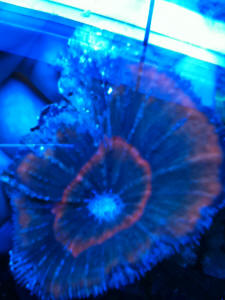 |
|
Re: Need help with sick Australomussa
6/18/12
Thank you so much for taking the time to help me. You saved the
day!
Tyler
<Happy to assist your efforts. BobF>
|
|
Unknown LPS disease! 5/28/12
Hello WWM!
<Cass>
Having some major issues and would be very grateful if you could offer
some information or solutions.. details below...
all of my LPS in my nano are melting away in a particularly weird way.
They start out with displaying their stinger tentacles in mass all at
once then a few days later progress to mush... It appears to be a lot
different the brown jelly though.
<The given name for this condition...>
This happened right after i setup the nano, so i took it down and
started over thinking i had some kind of pathogen. I cycled tank, cooked
rock, added new sand..etc. . put in some tester corals and all seemed
well. Ordered some Acans.. and a few days later two colonies are doing
the same exact thing. Other colonies are completely unaffected. However
the last time they were hit one by one and all eventually died.
All param.s are spot on. 78 Deg, dKH 8 sg 1.026 ca 420 mg 1350. p04 is
undetectable. No ammonia, or nitrate either. Any soft coral varieties
seem to be unaffected. Fish/inverts are also fine. ORP, ph, temp, photo
period all stable/consistent as well.
Pictures are below.. they show how it starts out and what is progresses
too. Also dipping just finishes them off completely - so that's not an
option. I tried Lugol's, revive and others all to the same effect. Any
ideas what is going on here? I was thinking some kind of contaminate but
have done my best to rule that out by tearing down the tank and starting
over. I switched salt, changed ro/di, food, cooked rock, new sand, not
dosing anything, new carbon and gac.. basically new everything except a
new tank (which was cleaned very well)!
Thank you for your advice and happy Memorial Day!
Cassidy
<Likely a simple example of allelopathy (see WWM re)... a bane of
too-small volumes w/ too many disparate Cnidarians present... I'd keep
changing water, add an over dose of iodide-ate, a teaspoon of a hexose
of your choice and reduce the spg. by a thousandth... In the longer
haul, you need more volume at least. Bob Fenner>
|
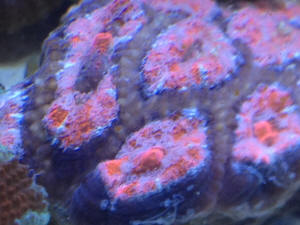
[1].jpg) |
Re: Unknown LPS disease!
5/28/12
Thank you for the quick reply. The tank is primarily Acan lords. There are a
few stalks of Duncans, Zoas,
<Most likely candidate for toxicity>
and palm tree corals. Will Acans lords compete with other Acans?
<Not much, no>
Always though the same species would live happily in close proximity. I
planned it to be an Acan tank. Also not familiar with hexose?
<Six ringed sugars... use the Net>
Any suggestions on what to purchase?
<All sorts>
Thank you,
Cassidy
<Welcome. BobF> |
Acan Coral Budding behavior
3/17/12
Hello All, I have searched your site and others like it and have been
unable to find an answer to my question.?
<Have you?>
I recently acquired a Acan frag from my LFS, when introduced to
my tank it looked great.?
<Did it or not?>
My water Param.s are nitrates 0, nitrites 0,
phoshates;.2, ammonia 0, calcium 500,
<Too high, and this and all other photosynthates need measurable NO3
and HPO4...>
temp 80, ph 8.1, Alk 13. It is a 29 gal tank
with 25 lbs live rock and Caribbean live sand.?
<What's w/ the ???>
I do 20% water changes weekly.? I had a hair algae outbreak a
while back and my Acan closed up, I got everything taken care of,
reduced feedings and lowered photoperiod as well as scrubbed the LR in
a old tank water bath.?
Did a 50% water change and all has been great since then.? My
Acan, Bubble,
<Likely the allelopathogenic winner here... the Acanthastrea
losing>
Sun corals are loving it as well as my polyps and
mushrooms.?
<These too>
When the Acan reopened there were two new heads on it,
needless to say I was overjoyed.?
<Mmm, I wouldn't be... too likely
"stress-related"...>
Now, its partially closed and I am very nervous again.? Is it closing
up a part of its budding process or is this just a coincidence?? Any
help you can give will be appreciated, your website is very
informative.?Thank you for all you do.
<... See/read on WWM re the above issues... soluble nutrients,
Cnidarian allelopathy. Short/est answer; If I had another established
system, I'd be moving this Mussid. Bob Fenner>
Scolymia, Hlth., reading
2/15/11
<... where is your grammar Dan?>
dear crew
i received a Scolymia about 2 months ago. when i got it , it was about
12inch in diameter when full expanded.
<Wow!>
a couple of days ago it started to retract . it now only covers its
hard skeleton. i did a water change once i noticed it retracting, and
I'm in the process of doing another one. all my other corals
LPS
<These are likely at play.... Allelopathy>
and Clam are doing fine, fish as well. here are my parameters,
Ca 420
Alk 177 ppm
Mg 1300
1.025 salinity
NO3 - 0
<Need some>
PO4 -.05
any thought on whats going on or how to fix the problem? is it normal
for a Scolymia to through cycles of expanding and retracting during the
day?
thanks in advance
Dan
<Read here: http://wetwebmedia.com/MussidDisF4.htm
and the linked files above, and: http://wetwebmedia.com/cnidcompppt.htm
and... Bob Fenner>
Re: Scolymia- 2/16/11
Thank you for the information. If it is chemical warfare that is
causing the Scolymia to retract which one of these corals is a possible
culprit?
<Yes>
Favia, Xenia, Ricordea, pink BTA, green BTA, frog spawn, various
Zoanthids.
Other then running carbon filtration, doing water changes and removing
the suspect coral is there anything else I can do?
<... read where you were referred to. The best would be to remove
the Mussid to another system, "condition" it to the presence
of the other Cnidarians through partial water changes for weeks>
I don't think it could be the Zoanthids as most of them came from
the same tank as the Scolymia.
Any help would greatly be appreciated,
with thanks
Dan
<Keep reading. BobF>
Re: Scolymia- 2/16/11
oh yeah I also have some green star polyps
<... also high on the "noxious" list. B>
|
Dying Coral? A joke? No data of use or reading
6/27/10
I am not really sure exactly what type of coral this is.
<...? Looks like a "melting Mussid" of some sort...
perhaps a Lobophyllia sp.>
I have had it for about a year and it has always been beautiful.
The last week however it has really started to droop badly.
<!>
I have read that corals droop like this when they are
stressed,
<... to the point of dying>
but I don't know what is stressing it. It was located near a
spot where I had recently placed some new stuff
<...>
and I thought that may be the problem, so I moved it up higher in
the aquarium so it would get more light and airflow, but so far
it isn't helping.
<What? Is this a joke? Really? Read on WWM re the family,
allelopathy. Bob Fenner>
|
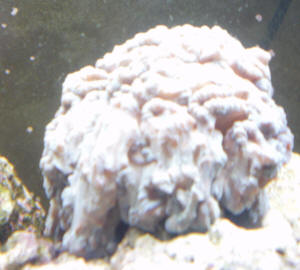 Melt down! Melt down! |
|
Re: Dying Coral? Mussid... 6/27/10
Maybe I am just stupid, but I really do not understand your
response. I have looked on your website and the only thing I find
that may help is that maybe I need to move to coral to where
there is less airflow, but as far as what is causing my problem I
am still at a loss.
<... what? Again... is this a joke? B>
Re: Dying Coral?
This is no joke and I am getting a little annoyed. I am looking
for help in keeping my coral healthy.
<Please see re the family... Mussidae.... on WWM. B>
|
|
White dots on Acan 6/23/10
Dear Bob,
<Ioannis>
How are you?
<Fine, thank you>
For the last 3 days I have been seeing white dots on one of my
Acans I have not been able to find any information online,
Eric's aquarium corals
or Anthony's Book of coral propagation. So hence my
email.
<These are bits, the second pic "mesenterial
filaments" of the corallite soft tissue "coming
out"... indicative of very stressful condition/state>
First of all let me give you some water parameters as of today
and some basic info
*Date of establishment:* 10th November 2009
*Net tank volume*: Estimated 80 liters
<Small>
*Filtration:* RDSB & Refugium (No skimmer)
*Date*: 22 June 2010
*Temperature*: 24.8 C
*Salinity*: 35 PPT
*NH4*: 0
*NO2*: 0
*NO3*: 0.2-0.5 (normally around 1 but I didn't feed
yesterday)
*PO4*: <0.03
*PH*: 8.0
*KH*: 7.0 (dropped by 1dkh the last 2 days)
*Ca*: 425
*Mg*: 1350
*Last water change*: 19th & 20th June (12 and 10Liters
respectively.
Normally about 15L WC but I prepared more water by accident so I
decided to split it in 2 days to avoid any shocks)
Attached you will find 3 pictures of the Acan.
Picture 1 was taken yesterday
Picture 2 was taken yesterday after a 2 minute FW dip. Note that
the white
stuff that normally comes out of the mouth after a dip can also
be seen at
the areas where the white dots where.
Picture 3 was taken today. Note the dots are more this time.
Now correct me if I am wrong but this strikes me as strange as
my
parameters
have been in check for a long time now (exception of the rapid
KH, Ca and Mg usage for which I am building a Calcium
reactor).
<Your readings are fine, but there is much more going on in
systems that is not tested for>
Furthermore the coral in question is placed on the sandbed along
with 9 other Acans which seem to be
fine.
<These may well be mal-affecting each other in this small
volume. I would separate them... put some in other systems. And
treat with "iodine"; read here re: http://wetwebmedia.com/ioddosingf.htm
and the linked files above>
Difference is that this Acan is closer to the live rock. I would
also like to mention that the coral expands normally during the
day (the tank receives small amounts of indirect sunlight) and
even better when the lights go on.
My personal guess is that something is nibbling on the coral.
<Mmmm, may be...>
Tank inhabitants are 2 true Percs and 2 blood shrimps. Until now
I have never seen the shrimps nibble on a coral before. I also
spot feed them every other day before I feed my Tubastrea so they
receive a good share of food.
Lastly and perhaps more importantly, a long time ago I spotted a
small white crab and didn't do anything about it. Yesterday I
managed to see it ( or at least I THINK I did) within the
rockwork for a split second and it seems that its much bigger
now. Would the bottle trap work or would my shrimps get in there
instead?
<Worth trying. You can always release the shrimps>
By the way, I would also want to add that my Blasto and micro
have started RTN'ing a bit since yesterday.
<I'd like you to read over a ppt. presentation I have
posted on avoiding Allelopathy: http://wetwebmedia.com/cnidcompppt.htm
and as much of the linked files above as you find it takes for
you to understand>
I FW dipped them
<Not completely freshwater I hope/trust... and with... oh, I
see below you mention I2.>
yesterday but the Blasto seems to be getting worse. I am planning
to do a Betadine dip (3ml per 1L tank water for 10 minutes) to
help out.
<Good... and I'd add a triple-dose of iodide-ate to the
system water itself>
In the meantime I have ordered Fauna Marin's Ultra Pest
control but it wont be here for another week. Seems a bit too
long, hence the Betadine (cant get Lugol's in the Netherlands
unfortunately).
<I wonder why not? I'd look around for similar products.
There are several>
Sorry for the long message but I thought it would be easier to
provide all relevant info (figured you'd ask anyway :P).
Anyway, given the above, what do you think is the culprit?
<Allelopathy most likely... negative interaction twixt the
Cnidarians here.
"Curing" this can be done, takes time, having other
systems>
Any advice would be very appreciated
Regards,
Ioannis
<And you, BobF>
|
 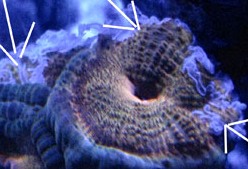 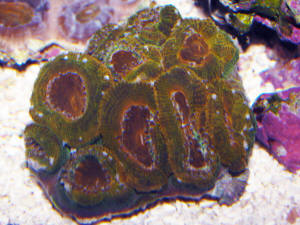 |
|
Re: White dots on Acan 6/23/10
Hey Bob,
Than you for your reply!
I was aware of the small volume, the tank itself is about 45-50L
(net) of that volume.
<Yes, way too small for what you have here>
Within a week or 2 I will be upgrading my filtration and volume
big-time (I think roughly 50L more system volume) though. I have
ordered a 100L tank to upgrade my current RDSB and Refugium.
The second picture was right after the dip, hence the stressed
appearance as you mentioned. Anyway, yesterday I spot fed the
coral (I had neglected to do so for about 2 weeks) and to my big
surprise most of the spots are gone
today. There are still some on the left side but its much better
than yesterday.
<Ah good!>
As about allelopathy, I just took a look at your slides and there
is lots of good info. For the record, I was keeping myself more
occupied with chemical wars (hence why I have no softies in the
tank) and space issues until now.
Most corals have room for growth although some are starting to
get big.
This is the reason why I will be fragging 3 of my Acans (about 5x
the size of the rest of the Acans) right after my vacation. Just
as a side note, I have seen some good growth on some of the
corals, especially my torch (split a new
head 2 days ago and 2 more are well on their way)
<Also positive news>
Yesterday I tried to catch the shrimps but didn't succeed. I
will try to get them to climb on my hand (they will do that
sometimes) and net them. I am planning to put them in the
refugium temporarily until I can catch that crab.
<Good plan>
As about the Blasto, it seems that the Betadine dip did something
after all.
The RTN does not seem to have spread out, although the coral has
not expanded its polyps since the dip.
You said to dose iodide-ate and came up with one from Seachem on
the web.
Is it safe to add this to a system of this size?
<Yes. A very good product, line, manufacturer>
Also, wouldn't those levels by sustained given that I am
religious with my water changes and that am not skimming? (as I
understand aggressive skimming can remove iodide and other
elements)
<Not so... iodide and iodate are taken up/out of solution w/in
days of dosing, addition through (some) synthetic salt mixes,
foods>
By the way, I have heard of stories of people adding Betadine
inside their displays tanks. Are you familiar with this?
<I am. Better to add these other valence states... Iodine
itself is quite toxic>
Funny thing about Lugol's. I went to my local pharmacy
yesterday and asked for it. The looked at me as if I was some
kind of moron lol.
<Perhaps this/it is called something else there... I'd ask
them to look the ingredient names up in their references>
Needless to say they had never heard of it. I will check for
alternatives just in case (although Betadine should do the job
for now)
Once again thank you for the great support!
Regards,
I. Mylothridis
<Welcome my friend. BobF>
Re: White dots on Acan 6/23/10
Hey Bob,
Thank you for your reply!
I was aware of the small volume, the tank itself is about 45-50L
(net) of that volume.
<Yes, way too small for what you have here>
Within a week or 2 I will be upgrading my filtration and volume
big-time (I think roughly 50L more system volume) though. I have
ordered a 100L tank to upgrade my current RDSB and Refugium.
The second picture was right after the dip, hence the stressed
appearance as you mentioned. Anyway, yesterday I spot fed the
coral (I had neglected to do so for about 2 weeks) and to my big
surprise most of the spots are gone today. There are still some
on the left side but its much better than yesterday.
<Ah good!>
As about allelopathy, I just took a look at your slides and there
is lots of good info. For the record, I was keeping myself more
occupied with chemical wars (hence why I have no softies in the
tank) and space issues until now.
Most corals have room for growth although some are starting to
get big.
This is the reason why I will be fragging 3 of my Acans (about 5x
the size of the rest of the Acans) right after my vacation. Just
as a side note, I have seen some good growth on some of the
corals, especially my torch (split a new head 2 days ago and 2
more are well on their way)
<Also positive news>
Yesterday I tried to catch the shrimps but didn't succeed. I
will try to get them to climb on my hand (they will do that
sometimes) and net them. I am planning to put them in the
refugium temporarily until I can catch that crab.
<Good plan>
As about the Blasto, it seems that the Betadine dip did something
after all.
The RTN does not seem to have spread out, although the coral has
not expanded its polyps since the dip. The You said to dose
iodide-ate and came up with one from Seachem on the web.
Is it safe to add this to a system of this size?
<Yes. A very good product, line, manufacturer>
Also, wouldn't those levels by sustained given that I am
religious with my water changes and that am not skimming? (as I
understand aggressive skimming can remove iodide and other
elements)
<Not so... iodide and iodate are taken up/out of solution w/in
days of dosing, addition through (some) synthetic salt mixes,
foods>
By the way, I have heard of stories of people adding Betadine
inside their displays tanks. Are you familiar with this?
<I am. Better to add these other valence states... Iodine
itself is quite toxic>
Funny thing about Lugol's. I went to my local pharmacy
yesterday and asked for it. The looked at me as if I was some
kind of moron lol.
<Perhaps this/it is called something else there... I'd ask
them to look the ingredient names up in their references>
Needless to say they had never heard of it. I will check for
alternatives just in case (although Betadine should do the job
for now)
Once again thank you for the great support!
Regards,
I. Mylothridis
<Welcome my friend. BobF>
|
|
Acanthastrea having issues 2/17/10
Hi Crew,
<Vic>
Long ago in another lifetime you answered some questions about a
freshwater setup that I had at the time- thanks for that and for
all the advice you give your readers. I always recommend this
site to my friends and new people in the hobby.
I've since graduated to reefkeeping. I currently have a 29
gallon biocube which I have modified in several ways. It has a
Nano-Doc skimmer, filter floss, a Koralia-1, and two return pumps
instead of one. I haven't upgraded
the stock lighting (but I am planning an LED retrofit project).
I've installed a homemade media basket strongly lit on a
reverse day cycle in which I am growing Chaetomorpha for nutrient
export. I feed fish a small amount of Spectrum pellets every day,
and try to feed the corals frozen Mysis or brine shrimp once
every 2-3 days, and all of the other animals take
part in the feeding.
I have a couple questions and one in particular (about my Acans)
that I was hoping you could answer. First, the usual preliminary
info...
Current inhabitants:
2x juvenile black Ocellaris clowns
Acanthastrea sp. <-- this is the coral in question
Several Zoanthids
Pachyclavularia violacea
Dendrophyllia fistula (not sure if this is the exact species...
"real"
Dendros, not sun coral)
Ricordea florida
Euphyllia divisa
Lobophyllia sp. (red border, turquoise center)
Sarcophyton (neon green)
Seriatopora hystrix (hyacinth)
Seriatopora guttata (green)
Montipora capricornis (orange)
Euphyllia glabrescens
Duncanopsammia axifuga
Cyphastrea ocellina
Clavularia sp. (purple snowflake cloves)
Xenia umbellata
Favia sp. (Christmas Favia)
Montipora digitata
Ricordea yuma
<... all this in a 29 gal. cube?!>
4x Thor amboinensis sexy shrimp
1x Red skunk cleaner shrimp
2x Bumblebee snails
3x Mexican turbo snails
6x Cerith snails
4x Nassarius snails
That sounds like a lot now that I listed it all out but they are
mostly smaller frags of a few heads or branches. The tank has
been set up for several months. I'm pretty OCD about it and I
feel that while stocking may appear to be heavy for a tank this
young, I added each coral individually and kept tabs on the water
parameters the whole time, with religious 5gal/week water changes
(or more). I also change my filter floss every other day, as soon
as it turns light brown.
<Okay>
Water parameters are all within acceptable levels. Last
checked:
ph : 8.3
Ca : 390 ppm
dKH : 9.5
PO4 : 0 - .25 ppm
NO3 : 5 ppm (did a few water changes after this reading)
sg : .023
<Mmm, I'd raise this and keep in steady at 1.025>
temp : ~79
With the exception of my Acans which have been very healthy
looking up till now, all of the corals are doing well. They are
all growing- even the birdsnest and Montis both of which are usually recommended for systems
with more light than the PC bulbs in my stock hood. I have them
up high in the center of the tank where the PAR is highest, with
good results. I haven't seen any signs of stress or disease
on any other corals in the tank and have yet to lose a single
animal so far.
When I got the Acans they had been fragged a couple weeks earlier
and were still recovering from that- some of the heads were only
partial and the skeleton was visible on all sides. In the few
months I had them, they have fully recovered and all of them had
essentially regrown the full circle of their outer flesh.
<Only the first pic "came through" and it looks very
nice indeed. Oh, got the second one to "save"... it
looks fine as well>
I have a couple beautiful shots of them at this stage. A few days
ago I noticed a sexy shrimp sitting on the inner disc of one of
the Acan heads picking at a whitish looking thing that looked
like it was stuck in or coming out of the mouth of the polyp.
<Mmmm... summat going on here>
I wasn't sure what it was but thought it might be some sort
of waste, having seen these shrimp eat Lobophyllia poop many
times. I saw it the next day in the same spot and the coral was
clearly in some kind of distress- or at least did not appear
normal at all. This white thing, I discovered, was actually a bit
of skeleton. I'm not sure if it was always there and just
right below the surface of the polyp but I hadn't seen the
skeleton in that spot before. A couple days later the issue had
progressed and the edge of the Acan was developing some kind of
tear or recession. The other heads on the colony and even the
other side of the affected polyp appear to be doing alright- an
adjacent polyp does look like its having a similar thing happen
on its outer flesh ring, though, and I'll keep an eye on
it.
<Good>
I've attached a picture of the same coral eating some Mysis
while healthy a few weeks ago, and another one that I took last
night with my phone - please excuse the graininess.
Any idea what this could be?
Bacterial infection?
Some parameter that would only affect the Acan?
Is this some weird type of polyp reproduction/splitting?
Damage from sexy shrimp picking at it?
<Maybe one of these or another possibility... one of the
clowns or another invertebrate chewing>
On this note, I have seen them 'picking' at corals before
including this Acan, my Seriaptora, and even saw them rolling
around a Zoanthid that had either come off on its own from a
fresh frag or was "removed" for a sexy shrimp feast.
It's annoying but I try to keep them well fed to curb these
impulses. They mainly hang out on the Lobophyllia which does not
seem to mind their presence, but I frequently see them reaching
down into a mouth with their evil little pincers.
<These little Thor are generally not problematical... are more
opportunistic by far than predaceous>
It may or may not be related- my Ocellaris clowns were recently
introduced to the tank a week or two ago after two months in a
hospital/quarantine tank to guarantee that I did not have any
marine Ich. In the last five days, one of them has developed a
moderate fin rot on the front of its dorsal fin.
I'm not sure what could have caused it.
<Maybe rubbing against the Acanthastrea>
They don't look stressed, there are no other aggressors in
the tank, and the water checks out. Both are eating and have
ravenous appetites. They have been trying to host in my torch
coral.
maybe they hurt themselves on the skeleton somehow?
<Yes; easily so>
I am moving them to my hospital tank and treating with Maracyn 2
starting tonight,
<Mmm, I wouldn't be moving so fast here... unless
they're in obvious trouble, I'd leave them where they
are>
but it's disheartening to have them get sick all of a sudden
with no obvious cause.
Any ideas on the fin rot?
<Interaction with...>
How long should I have them in the hospital tank before returning
them to the main tank for this treatment? I am fairly certain
that at this point with some of the dorsal fin bones exposed,
treatment is absolutely necessary and the fish will not recover
without medication... correct me if I'm wrong.
Thanks for reading and for any advice that you can give.
Victor
<Welcome. Bob Fenner>
|
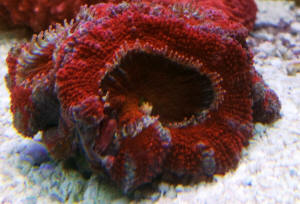 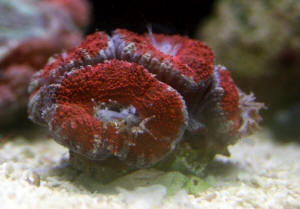 |
|
Re: Acanthastrea having issues
2/17/10
Comments/further questions added inline. Thanks for the response
Bob!
> Hi Crew,
> <Vic>
> Long ago in another lifetime you answered some questions
about a freshwater
> setup that I had at the time- thanks for that and for all
the advice you
> give your readers. I always recommend this site to my
friends and new people
> in the hobby.
> I've since graduated to reefkeeping. I currently have a
29 gallon biocube
> which I have modified in several ways. It has a Nano-Doc
skimmer, filter
> floss, a Koralia-1, and two return pumps instead of one. I
haven't upgraded
> the stock lighting (but I am planning an LED retrofit
project). I've
> installed a homemade media basket strongly lit on a reverse
day cycle in
> which I am growing Chaetomorpha for nutrient export. I feed
fish a small
> amount of Spectrum pellets every day, and try to feed the
corals frozen
> Mysis or brine shrimp once every 2-3 days, and all of the
other animals take part in the feeding.
> I have a couple questions and one in particular (about my
Acans) that I was
> hoping you could answer. First, the usual preliminary
info...
> Current inhabitants:
> 2x juvenile black Ocellaris clowns
> Acanthastrea sp. <-- this is the coral in question
> Several Zoanthids
> Pachyclavularia violacea
> Dendrophyllia fistula (not sure if this is the exact
species... "real"
> Dendros, not sun coral)
> Ricordea florida
> Euphyllia divisa
> Lobophyllia sp. (red border, turquoise center)
> Sarcophyton (neon green)
> Seriatopora hystrix (hyacinth)
> Seriatopora guttatus (green)
> Montipora capricornis (orange)
> Euphyllia glabrescens
> Duncanopsammia axifuga
> Cyphastrea ocellina
> Clavularia sp. (purple snowflake cloves)
> Xenia umbellata
> Favia sp. (Christmas Favia)
> Montipora digitata
> Ricordea yuma
> <... all this in a 29 gal. cube?!>
Yes, it sounds like a lot but if you saw a picture I'm sure
it would seem a lot more realistic. They're all very small
specimens. With proper water changes and placement, aggressive
skimming, etc I think it'll be ok.
<<Ah yes. I have seen very much more involved/stocked small
systems...
All's fine as long as folks do as you state you have done...
start w/ small specimens, acclimate them properly... TILL the
colonies all get larger, begin to impinge on each
other.>>
> 4x Thor amboinensis sexy shrimp
> 1x Red skunk cleaner shrimp
> 2x Bumblebee snails
> 3x Mexican turbo snails
> 6x Cerith snails
> 4x Nassarius snails
> That sounds like a lot now that I listed it all out but they
are mostly
> smaller frags of a few heads or branches. The tank has been
set up for
> several months. I'm pretty OCD about it and I feel that
while stocking may
> appear to be heavy for a tank this young, I added each coral
individually
> and kept tabs on the water parameters the whole time, with
religious
> 5gal/week water changes (or more). I also change my filter
floss every other
> day, as soon as it turns light brown.
> <Okay>
> Water parameters are all within acceptable levels. Last
checked:
> ph : 8.3
> Ca : 390 ppm
> dKH : 9.5
> PO4 : 0 - .25 ppm
> NO3 : 5 ppm (did a few water changes after this reading)
> sg : .023
> <Mmm, I'd raise this and keep in steady at
1.025>
It actually is higher than 1.023, usually 1.024 or so when I put
the water in and raises a bit with evaporation in between top
offs. Not a significant amount. Good advice though, I think that
was a typo on my part.
<<Good for me to (re) state; esp. for browsers>>
> temp : ~79
> With the exception of my Acans which have been very healthy
looking up till
> now, all of the corals are doing well. They are all growing-
even the birds
> nest and Montis both of which are usually recommended for
systems with more
> light than the PC bulbs in my stock hood. I have them up
high in the center
> of the tank where the PAR is highest, with good results. I
haven't seen any
> signs of stress or disease on any other corals in the tank
and have yet to lose a single animal so far.
> When I got the Acans they had been fragged a couple weeks
earlier and were
> still recovering from that- some of the heads were only
partial and the
> skeleton was visible on all sides. In the few months I had
them, they have
> fully recovered and all of them had essentially regrown the
full circle of
> their outer flesh.
> <Only the first pic "came through" and it looks
very nice indeed>
I've reattached the "sick" picture. I think only
the healthy one went through.
<<I did "recover" both... they both appear fine
to me. The one bad/exposed bit is not necessarily "that
bad">>
> I have a couple beautiful shots of them at this stage. A
> few days ago I noticed a sexy shrimp sitting on the inner
disc of one of the
> Acan heads picking at a whitish looking thing that looked
like it was stuck
> in or coming out of the mouth of the polyp.
> <Mmmm... summat going on here>
See pic. Looks not good for sure, just not sure if you've
seen this before and can make some sort of diagnosis with the
picture.
<<Looks like a mechanical injury. Again, I would do nothing
overt here>>
> I wasn't sure what it was but
> thought it might be some sort of waste, having seen these
shrimp eat
> Lobophyllia poop many times. I saw it the next day in the
same spot and the
> coral was clearly in some kind of distress- or at least did
not appear
> normal at all. This white thing, I discovered, was actually
a bit of
> skeleton. I'm not sure if it was always there and just
right below the
> surface of the polyp but I hadn't seen the skeleton in
that spot before.
A couple days later the issue had progressed and the edge of the
Acan was
> developing some kind of tear or recession. The other heads
on the colony and
> even the other side of the affected polyp appear to be doing
alright- an
> adjacent polyp does look like its having a similar thing
happen on its outer
> flesh ring, though, and I'll keep an eye on it.
> <Good>
I fed last night and all of the polyps took the food, but the one
with apparent tissue damage had a clear problem
"swallowing" the brine shrimp.
<<No big>>
> I've attached a picture of the same coral eating some
Mysis while healthy a
> few weeks ago, and another one that I took last night with
my phone - please excuse the graininess.
> Any idea what this could be?
> Bacterial infection?
> Some parameter that would only affect the Acan?
> Is this some weird type of polyp reproduction/splitting?
> Damage from sexy shrimp picking at it?
> <Maybe one of these or another possibility... one of the
clowns or another invertebrate chewing>
The clowns don't go near the Acanthastrea. They really only
ever "touch" the Euphyllia species, and even then
mainly the torch. Sometimes the frogspawn.
<<Might have been done when no one was watching>>
> On this note, I have seen them
> 'picking' at corals before including this Acan, my
Seriaptora, and even saw
> them rolling around a Zoanthid that had either come off on
its own from a
> fresh frag or was "removed" for a sexy shrimp
feast. It's annoying but I try
> to keep them well fed to curb these impulses. They mainly
hang out on the
> Lobophyllia which does not seem to mind their presence, but
I frequently see
> them reaching down into a mouth with their evil little
pincers.
> <These little Thor are generally not problematical... are
more
> opportunistic by far than predaceous>
I hope not. They're attractive little creatures but I was
afraid that they were causing real harm to the coral.
<<Are some of my faves to look for when diving in the TWA,
Indian and Pacific Oceans>>
> It may or may not be related- my Ocellaris clowns were
recently introduced
> to the tank a week or two ago after two months in a
hospital/quarantine tank
> to guarantee that I did not have any marine Ich. In the last
five days, one
> of them has developed a moderate fin rot on the front of its
dorsal fin.
> I'm not sure what could have caused it.
> <Maybe rubbing against the Acanthastrea>
As I mentioned above, I don't think it was the Acan. If
anything it was the torch that might have hurt them.
<<Could well be>>
> They don't look stressed, there are no
> other aggressors in the tank, and the water checks out. Both
are eating and
> have ravenous appetites. They have been trying to host in my
torch coral..
> maybe they hurt themselves on the skeleton somehow?
> <Yes; easily so>
Thanks for clearing that up. I know that the torch has a sharp
skeleton but not sure how likely it was for the fish to hurt
itself.
<<Is sharp and their sting... can be very tough>>
> I am moving them to my
> hospital tank and treating with Maracyn 2 starting
tonight,
> <Mmm, I wouldn't be moving so fast here... unless
they're in obvious
> trouble, I'd leave them where they are>
The dorsal fin on the female is almost halfway gone, the front
half is just bones. I can see some tissue inflammation at the
base of the fin. A few days prior to that I saw stringy poo,
which I've understood to indicate some gastrointestinal
problem (bacteria, worms, something is amiss).
<<Mmm, a possibility; though not for sure>>
> but it's disheartening to have them get sick all of a
sudden with no obvious cause.
> Any ideas on the fin rot?
> <Interaction with...>
How long should I have them in the hospital tank before returning
them to the main tank for this treatment? I am fairly Still
curious if you have any advice about how long they should stay in
there after Maracyn treatment, possible avenues for root cause
other than
hurting themselves on the torch like chemical imbalances,
parasites...
<<Two weeks... I would "de-worm" them and treat
with an antiprotozoal =(Metronidazole) here as an
S.O.P.>>
> certain that at this point with some of the dorsal fin bones
exposed,
> treatment is absolutely necessary and the fish will not
recover without medication... correct me if I'm wrong.
> Thanks for reading and for any advice that you can give.
> Victor
> <Welcome. Bob Fenner>
Thanks again Bob, greatly appreciated.
<<Welcome Victor. BobF>>
Re: Acanthastrea having issues, Thor
amboinensis comp. w/ Cnid.s 3/2/10
Bob,
<Victor>
Thanks for the advice. I have a bit of an update and am only
following up because I'd hate to lose this specimen and it
does not appear to be improving so far.
<Ahh>
I think I've isolated the culprit(s); my Thor amboinensis.
Have you heard anything about them picking at corals?
<These little Hippolytids will do so if very hungry... I
consider them more opportunistic than predaceous>
I've heard that elsewhere amongst all of the proclamations
that they are "Reef safe" or "reef safe with
caution".
However, in the past months I've seen them constantly pick at
my Zoas and a large Palythoas that I have, as well as the Acan.
Before I was not sure whether they cause damage but they
certainly keep the Zoas closed and annoyed quite often.
Anyhow, I saw one of these shrimp perched on the Acan and picking
at it... maybe "tearing" is a more suitable word,
because it was literally pulling off pieces of the tissue. It
wasn't just the dead/dying tissue, but healthy-looking
portions of the polyps. The shrimp appeared to be putting quite a
bit of effort into each "yank" with its claws so it was
clearly pulling something off of the coral. I isolated this
shrimp and put it in a small plastic container within the tank,
and soon saw another shrimp doing the same thing. They're now
cellmates. The corals are open more than usual and I will keep an
eye on the Acan but it is really suffering. Is there any insight
that visual inspection can provide?
<Perhaps>
I've read that color of the revealed skeleton can indicate
bacterial infection. Should I continue feeding more or less
often?
<I'd check all over again, continue with best practices,
intervals>
Move it to higher or lower lighting/flow? Could continued
harassment by these small shrimp have caused progressive tissue
damage and eventual deterioration/death? How "far gone"
can the coral be and still recover?
<To the point of very little live tissue being extant>
I will probably be trading in these two meddlesome shrimp, and
possibly the other two if I see a pattern in their behavior.
Maybe the appetite for coral meat is an individual thing.
FYI my two clowns just finished their Maracyn 2 treatment in a
hospital tank and the fin is already recovering.
Thanks again,
Victor
<And you. BobF>
|
Re: Acanthastrea having issues
8/6/10
Bob,
<Hey Vic>
I just wanted to do a very late follow-up to this for the
sake of completeness and in case anyone else has something
similar. My Acanthastrea tissue necrosis slowed, stopped,
and then the colony recovered with a bang.
<Yay!>
In the place of the dead tissue, several babies grew back
and I went from 5 total polyps to somewhere around 10-12.
I've attached a recent picture and a picture when it
was at its worst.
<Very nice>
It could have certainly been a couple of the Thor
amboinensis with a taste for coral flesh, but it isn't
entirely clear what caused the damage. All recovery
occurred after I removed these shrimp from the tank.
Cheers! Thanks for all the hard work you guys and gals put
in. Victor
<Thank you for the follow-up here. BobF>
|
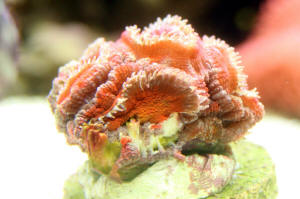 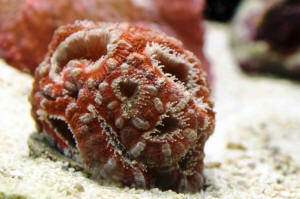 |
|
|
Acan Not Looking Good... no info. proffered, reading
ref. -- 1/27/10
Okay it has been a week now since I added these two Acans. My
water quality is good.
<... data please, not subjective commentary>
They are nearly at the top under two t5 bulbs in my AGA Standard
75 gallon tank with all the requirements good accept for maybe
the lighting.
<?... which is? Type of lamps, periodicity? This is assuredly
NOT enough intensity>
The red one seems to be doing good as you can see by the picture.
The other one seemed good at first but now it looks like it is
just going away. It disappears more each day. What can I do.
These are my first Acans but not
my first LPS. Could it be as simple as something picking on him.
What is going on with him.
Thank You,
Parker
<... Read here: http://wetwebmedia.com/mussiddisfaqs.htm
and the linked files above. Bob Fenner>
|
 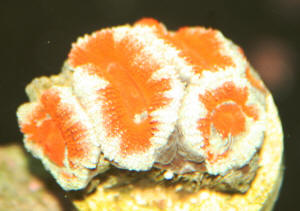 |
|
|

